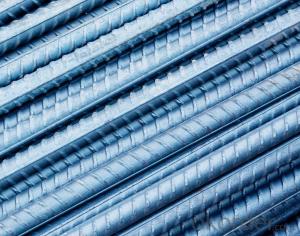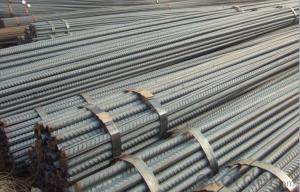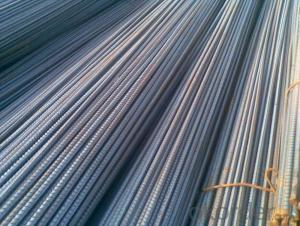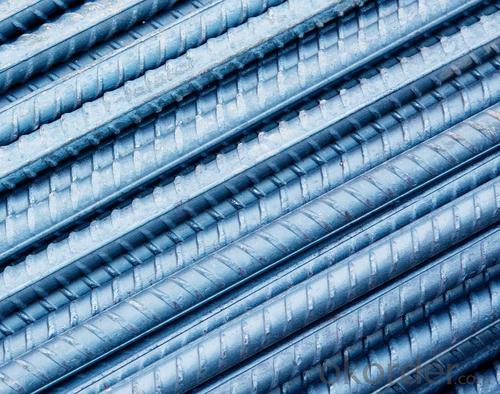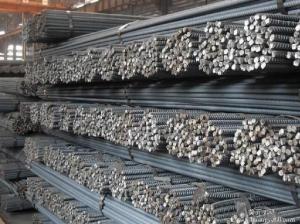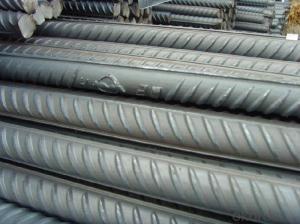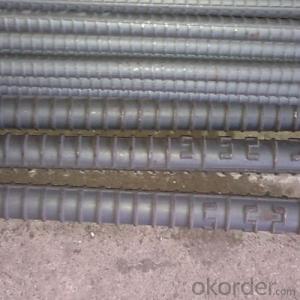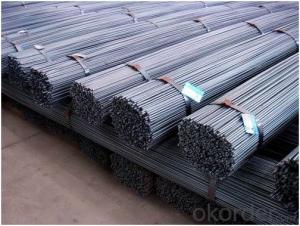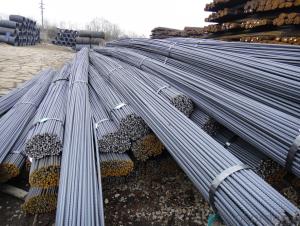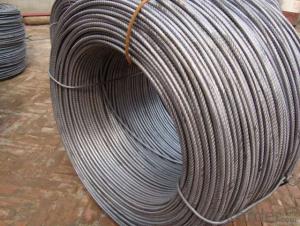High Quality Steel Deformed Bar HRB400 36/40/50mm
- Loading Port:
- Tianjin
- Payment Terms:
- TT or LC
- Min Order Qty:
- 100 m.t
- Supply Capability:
- 10000 m.t/month
OKorder Service Pledge
OKorder Financial Service
You Might Also Like
High Quality Steel Deformed Bar HRB400 36/40/50mm
Product Description:
Specifications of High Quality Steel Deformed Bar HRB400 36/40/50mm:
Standard | GB | HRB400 | |
Diameter | 36mm,40mm,50mm | ||
Length | 6M, 12M | ||
Place of origin | Hebei, China mainland | ||
Advantages | exact size, regular package, chemical and mechanical properties are stable. | ||
Type | Hot rolled deformed steel bar | ||
Chemical Composition of High Quality Steel Deformed Bar HRB400 36/40/50mm: (Please kindly find our chemistry of our material based on HRB400 as below for your information)
Grade | Technical data of the original chemical composition (%) | ||||||
C | Mn | Si | S | P | V | ||
HRB400 | ≤0.25 | ≤1.60 | ≤0.80 | ≤0.045 | ≤0.045 | 0.04-0.12 | |
Physical capability | |||||||
Yield Strength (N/cm²) | Tensile Strength (N/cm²) | Elongation (%) | |||||
≥400 | ≥570 | ≥14 | |||||
Theoretical weight and section area of High Quality Steel Deformed Bar HRB400 36/40/50mm as below for your information:
Diameter(mm) | Section area (mm²) | Mass(kg/m) | Weight of 12m bar(kg) |
36 | 1018 | 7.99 | 98.88 |
40 | 1257 | 9.87 | 118.44 |
50 | 1964 | 15.42 | 185.04 |
Usage and Applications of High Quality Steel Deformed Bar HRB400 36/40/50mm:
Deformed bar is widely used in buildings, bridges, roads and other engineering construction. Big to highways, railways, bridges, culverts, tunnels, public facilities such as flood control, dam, small to housing construction, beam, column, wall and the foundation of the plate, deformed bar is an integral structure material. With the development of world economy and the vigorous development of infrastructure construction, real estate, the demand for deformed bar will be larger and larger.
Packaging & Delivery of High Quality Steel Deformed Bar HRB400 36/40/50mm:
Packaging Detail: products are packed in bundle and then shipped by container or bulk vessel, deformed bar is usually naked strapping delivery, when storing, please pay attention to moisture proof. The performance of rust will produce adverse effect.
Each bundle weight: 2-3MT, or as required
Payment term: TT or L/C
Delivery Detail: within 45 days after received advanced payment or LC.
Label: to be specified by customer, generally, each bundle has 1-2 labels
Trade terms: FOB, CFR, CIF
FAQ:
Q1: Why buy Materials & Equipment from OKorder.com?
A1: All products offered byOKorder.com are carefully selected from China's most reliable manufacturing enterprises. Through its ISO certifications, OKorder.com adheres to the highest standards and a commitment to supply chain safety and customer satisfaction.
Q2: How do we guarantee the quality of our products?
A2: We have established an advanced quality management system which conducts strict quality tests at every step, from raw materials to the final product. At the same time, we provide extensive follow-up service assurances as required.
Q3: How soon can we receive the product after purchase?
A3: Within three days of placing an order, we will arrange production. The shipping date is dependent upon the quatity, how many sizes you want and the plan of production, but is typically 1 month to 2 month days from the beginning of production.
Images of High Quality Steel Deformed Bar HRB400 36/40/50mm:
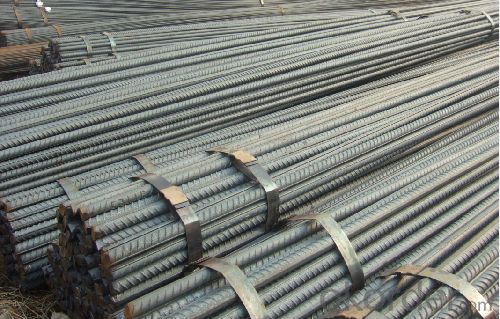

*If you would like to get our price, please inform us the size, standard/material and quantity. Thank you very much for your attention.
- Q: Are thread steels of coarse steel?
- The thread steel is not coarse steel and the thread steel belongs to the steel. Rough steel refers to the billet after casting steel. The billet has been rolled into various shapes of steel, including plates, profiles, tubes and so on.
- Q: Are steel rebars resistant to fire?
- Yes, steel rebars are highly resistant to fire. The high melting point of steel makes rebars withstand extreme temperatures and maintain their structural integrity during a fire. Additionally, the presence of steel rebars in concrete structures can help prevent spalling, which is the breaking off of concrete due to high heat exposure.
- Q: What is the lifespan of steel rebars in marine structures?
- The lifespan of steel rebars in marine structures can vary depending on various factors such as the quality of the steel, the environment in which they are exposed, and the maintenance practices employed. However, properly designed, constructed, and maintained marine structures with steel rebars can typically have a lifespan of 50 to 100 years. Steel rebars used in marine structures are generally coated with corrosion-resistant materials, such as epoxy or zinc, to protect them from the harsh marine environment. These coatings provide an additional layer of defense against corrosion, extending the lifespan of the rebars. However, it is important to note that the marine environment is highly corrosive due to the presence of saltwater, humidity, and other corrosive agents. Over time, these factors can lead to the degradation of the protective coatings and the exposure of the rebars to corrosion. If adequate maintenance measures are not taken, such as regular inspections, cleaning, and reapplication of protective coatings, the rebars may experience accelerated corrosion and their lifespan may be shortened. Additionally, the design and construction of marine structures play a crucial role in determining the lifespan of steel rebars. Proper considerations must be given to factors such as structural design, material selection, and detailing to minimize the risk of corrosion and ensure the longevity of the rebars. In summary, the lifespan of steel rebars in marine structures can range from 50 to 100 years, depending on factors such as the quality of the steel, the environmental conditions, and the maintenance practices employed. Proper design, construction, and maintenance are essential to maximizing the lifespan of steel rebars in marine structures.
- Q: Can steel rebars be used in reinforced masonry structures?
- Yes, steel rebars can be used in reinforced masonry structures. They are commonly used to provide additional strength and reinforcement to masonry walls and structures, helping to resist tensile forces and improve overall structural integrity.
- Q: How are steel rebars cut and shaped on-site?
- Steel rebars are typically cut and shaped on-site using handheld tools such as rebar cutters and benders. Rebar cutters are used to accurately cut the rebars to the required length, while rebar benders are used to shape the rebars into various configurations such as bends, hooks, or stirrups. These tools allow construction workers to customize the rebars according to the specific needs of the project, ensuring a precise and efficient installation.
- Q: How can steel rebars be recycled after their service life?
- Steel rebars can be recycled after their service life through a process called steel scrap recycling. This involves collecting the used steel rebars, sorting them, and then melting them down in a furnace. The molten steel is then shaped into new rebars or other steel products. This recycling process not only helps reduce the demand for raw materials but also minimizes waste and environmental impact.
- Q: What is the role of steel rebars in preventing concrete segregation?
- Steel rebars play a crucial role in preventing concrete segregation by providing reinforcement and support to the concrete structure. They help to distribute the load evenly throughout the concrete, preventing it from settling or separating. The presence of rebars helps to increase the tensile strength of the concrete, making it more resistant to cracks and fractures. Additionally, rebars help to control the shrinkage and expansion of the concrete, ensuring its stability and durability over time.
- Q: What is the process of threading steel rebars?
- The process of threading steel rebars involves using a specialized machine to cut threads onto the ends of the rebars, which allows them to be easily connected together. This threading process enhances the structural integrity, stability, and overall strength of the rebars when used in construction projects.
- Q: Are steel rebars susceptible to corrosion?
- Yes, steel rebars are susceptible to corrosion. Corrosion is a natural process that occurs when steel is exposed to moisture, oxygen, and other environmental factors. When steel rebars are used in concrete structures, they are exposed to the elements and can come in contact with water or moisture, which can lead to the formation of rust. This rust can weaken the rebars and eventually compromise the structural integrity of the concrete. To prevent corrosion, various protective measures can be taken, such as applying a protective coating or using corrosion-resistant steel rebars. Regular maintenance and inspection of the concrete structures are also crucial to detect and address any signs of corrosion in a timely manner.
- Q: What are the guidelines for repairing or replacing corroded steel rebars in existing structures?
- The guidelines for repairing or replacing corroded steel rebars in existing structures vary depending on the severity of the corrosion and the specific requirements of the project. However, there are some general guidelines that can be followed: 1. Assessment: Before proceeding with any repairs or replacements, a thorough assessment of the corrosion damage should be conducted. This may involve visual inspections, non-destructive testing, or even laboratory analysis of samples taken from the rebars. 2. Safety: Safety should always be the top priority when working with corroded rebars. Adequate precautions should be taken to ensure the safety of workers and surrounding areas. This may include the use of personal protective equipment and ensuring a stable work environment. 3. Determine the extent of corrosion: It is important to determine the extent of corrosion and whether it has affected the structural integrity of the rebars. This can help in deciding whether repair or replacement is necessary. 4. Repair methods: Depending on the severity of corrosion, various repair methods can be employed. These may include removing the corroded portion of the rebar and applying a corrosion inhibitor or protective coating, or using electrochemical techniques such as cathodic protection to prevent further corrosion. 5. Replacement: If the corrosion damage is extensive and repair is not feasible, the corroded rebars may need to be replaced. The replacement rebars should be of the same or higher grade and should be properly anchored to maintain the structural integrity of the existing structure. 6. Design considerations: When repairing or replacing corroded rebars, it is important to consider the design requirements of the structure. The repaired or replaced rebars should meet the necessary load-bearing capacity and should be properly integrated into the existing structure. 7. Quality control: Throughout the repair or replacement process, rigorous quality control measures should be implemented to ensure the effectiveness and durability of the repairs. This may include regular inspections, testing, and monitoring of the repaired or replaced rebars. It is important to note that these guidelines are general recommendations and should be tailored to the specific circumstances and requirements of each project. Therefore, it is advisable to consult with a structural engineer or a professional experienced in repairing corroded steel rebars for a more accurate and detailed guideline.
Send your message to us
High Quality Steel Deformed Bar HRB400 36/40/50mm
- Loading Port:
- Tianjin
- Payment Terms:
- TT or LC
- Min Order Qty:
- 100 m.t
- Supply Capability:
- 10000 m.t/month
OKorder Service Pledge
OKorder Financial Service
Similar products
Hot products
Hot Searches
Related keywords
